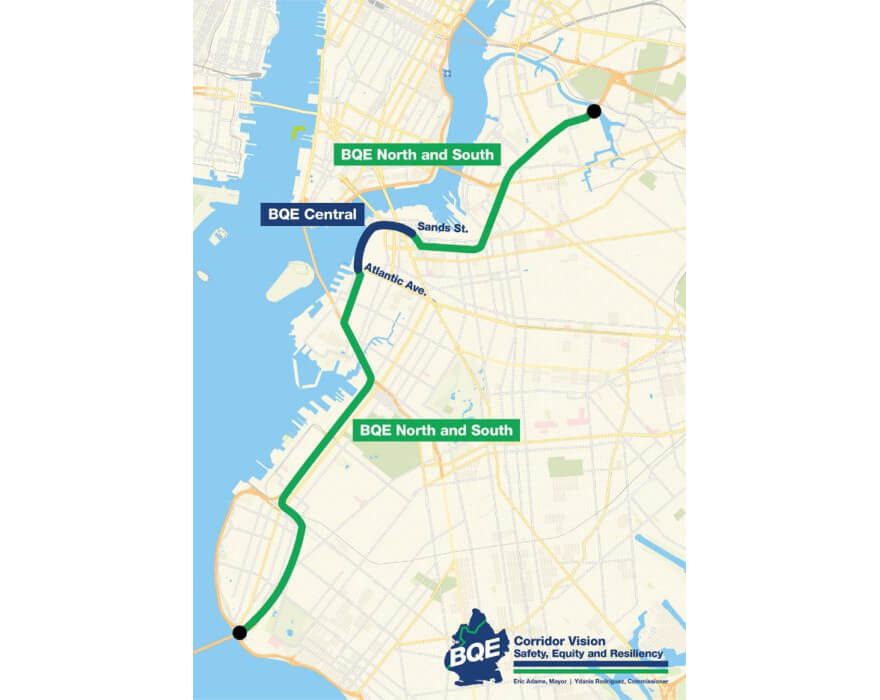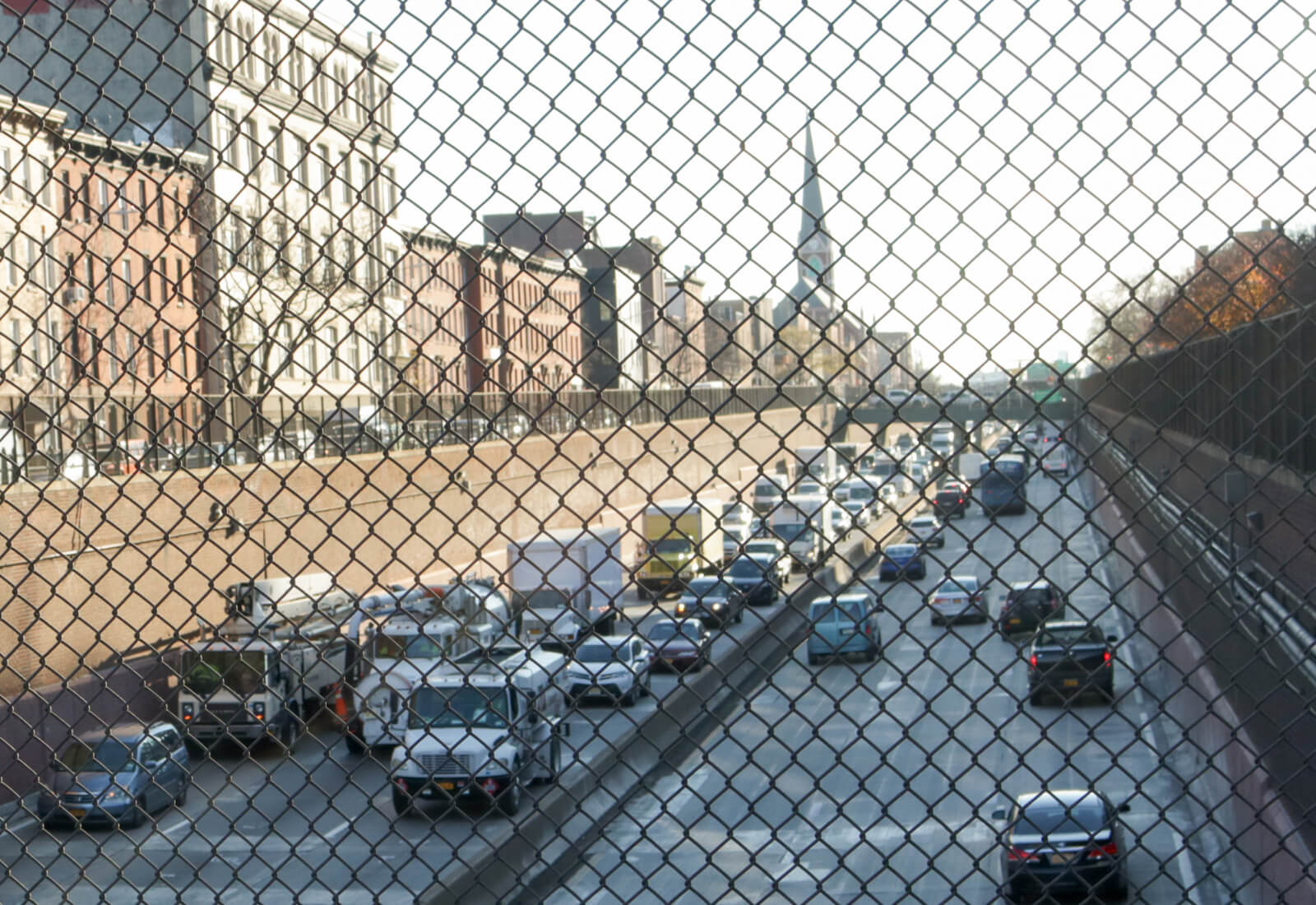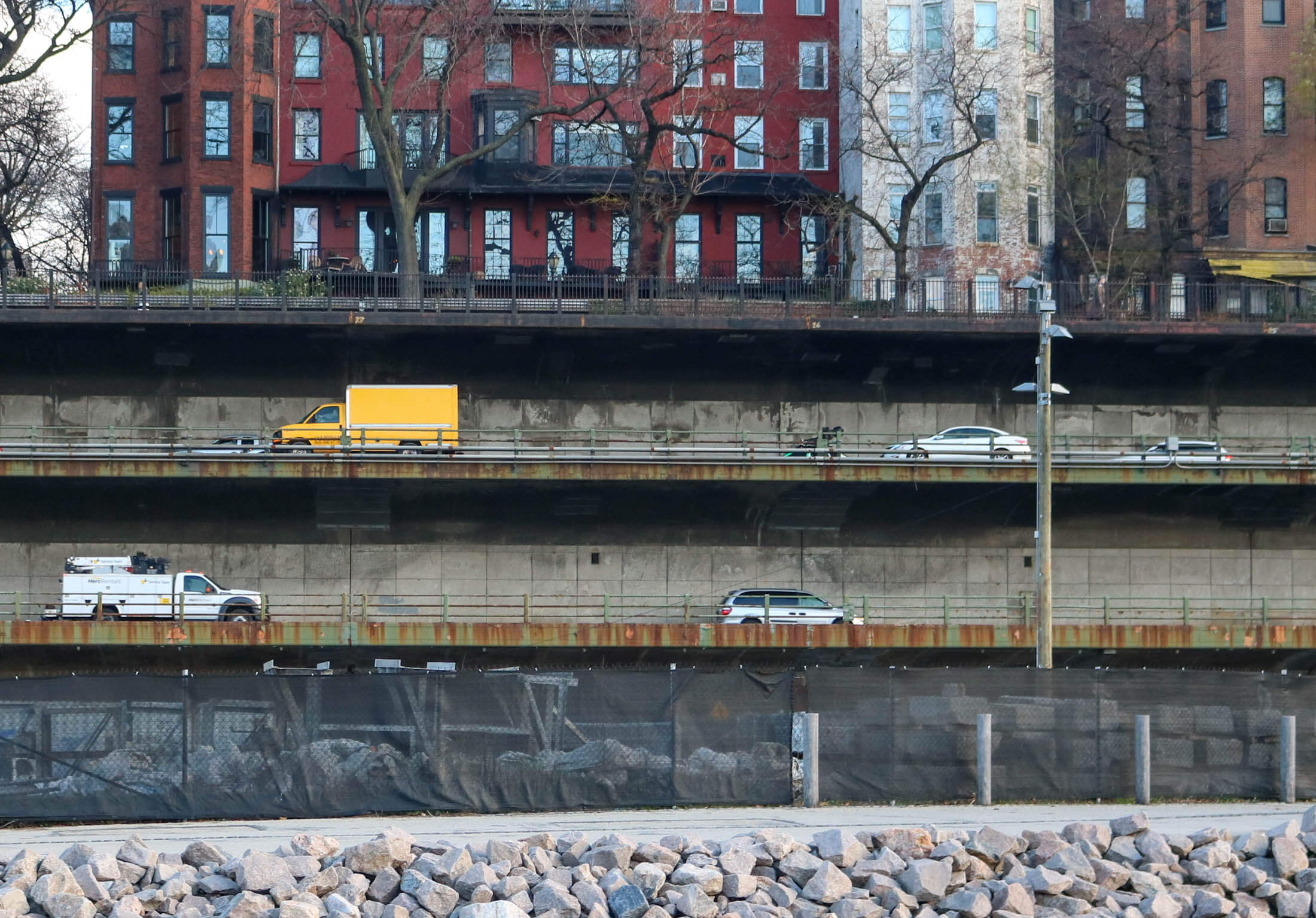Mayor Adams Wants to Keep the BQE, Plans to Counter Highway's 'Racism' With Parks, Plazas
The mayor wants to keep the Brooklyn-Queens Expressway and mitigate the “racism built into our infrastructure” by creating parks and plazas under the highway.

The BQE’s triple cantilever section in June 2022. Photo by Susan De Vries
It seems the mayor has made up his mind. The Brooklyn-Queens Expressway will stay, necessary repairs will be made, and the administration hopes to mitigate the “racism built into our infrastructure,” as he put it, by creating parks and plazas under the highway.
The new plan, consisting of two parts dubbed BQE Central and BQE North and South, will tap national funding available thanks to the recently passed Bipartisan Infrastructure Law. The decision was slipped into an announcement Friday of a forthcoming community engagement process.
At one time, Brooklynites debated getting rid of the highway altogether, as other cities have done, or replacing the crumbling cantilevered section that passes under the Brooklyn Heights Promenade with a ground-level roadway covered with green hills in Brooklyn Bridge Park. The Brooklyn Greenway Project has been creating parks and plazas under the highway for years in an attempt to knit back together the communities destroyed when Robert Moses built the BQE in the mid 20th century with federal highway funds.

Friday’s announcement was light on details about how exactly the rickety triple cantilever section will be repaired or rebuilt, but said immediate steps to maintain it are already in place, construction will begin in five years, and the Department of Transportation’s existing Triple Cantilever Joint Venture will continue.
That joint venture includes AECOM USA Inc., an engineering firm widely used in NYC projects that has proposed extending the subway to Red Hook and rebuilding the sleepy historic neighborhood with skyscrapers a la Hudson Yards. Also in the joint venture is high-profile Dumbo-based architecture firm Bjarke Ingels Group, one of two groups who have proposed replacing the existing cantilever with a ground-level roadway running through Brooklyn Bridge Park and covered by grassy hills.
Locals vehemently rejected DOT’s initial scheme to rebuild the cantilever by replacing the protected Brooklyn Heights Promenade with a temporary highway running just a few feet from landmarked townhouses overlooking the waterfront in Brooklyn Heights.

The DOT is planning “community outreach” to inform citizens of its plans and to help “develop designs for reuniting communities north and south of the BQE by creating public spaces like parks and plaza and providing new mobility options for commuting, recreation and commerce,” the press release said. “These communities have suffered for decades from increased traffic pollution and road safety risks after being divided by the highway,” it added.
“It’s time to take a new approach to the BQE and ‘Get Stuff Done,’” said Mayor Adams in the release. “Our administration is seizing a once-in-a-generation opportunity to partner with communities and develop a bold vision for a safe and resilient BQE. Together, we are finally confronting the racism built into our infrastructure and putting equity front and center to modernize this vital transportation artery now.”
DOT Commissioner Ydanis Rodriguez said in the release, “We must reckon with the harm these 20th-century highways have caused communities of color in New York City. While we undertake the BQE Central project, we will ensure we are also planning how best to reconnect other neighborhoods that have been split apart by this highway, from Bay Ridge to Greenpoint.”
The release listed a mix of virtual and in-person sessions:
September 28: Corridor-wide kickoff (virtual)
October 6: Corridor-wide kickoff (virtual)
October 11: BQE Central workshop (in-person)
October 13: BQE Central workshop (virtual)
November 3: BQE North and South workshop (virtual)
November 7: BQE South workshop (in-person)
November 10: BQE North workshop (in-person)

The mayor’s plans align with recommendations in a January 2020 report from the BQE Expert Panel, according to President and CEO of New York Building Congress Carlo Scissura, who chaired the report panel in 2019 and 2020.
The report rejected DOT’s initial proposal while stopping short of embracing Bjarke Ingels’ vision. A City Council engineering report the following month recommended the latter. Meanwhile, congestion pricing, which the city is currently considering, has the potential to further alter traffic patterns in Brooklyn and citywide.
“We also look forward to an eventual corridor-wide, full re-imagination of the BQE from Staten Island to The Bronx that serves people, communities and the entire city,” he said in a prepared statement quoted by Brownstoner sister pub Politics NY. “In the name of sustainability and equity for those impacted by the mistakes of yesteryear, all options for a greener, fully modernized, community-focused roadway must be considered.”
Related Stories
- Automatic Truck Tonnage Sensors to Prevent BQE Collapse Due to Arrive at Year End
- BQE Transformation on Hold, City Plans Weight Restrictions and Limiting Lanes Instead
- Mayor Pledges BQE Cantilever Repair While Full Fix Is Delayed
Email tips@brownstoner.com with further comments, questions or tips. Follow Brownstoner on Twitter and Instagram, and like us on Facebook.









What's Your Take? Leave a Comment